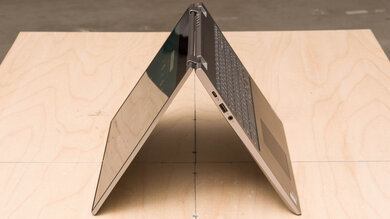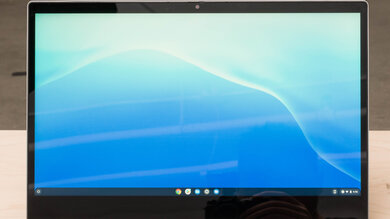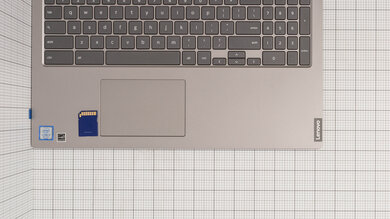The Lenovo Chromebook C340 15 (2020) is a 2-in-1 convertible laptop with a 360-degree hinge. It has a thin profile that makes it portable, and it feels impressively well-built, with a finish that doesn't scratch easily. Its battery life is outstanding, lasting over twelve hours of light productivity and nearly eight hours of video playback. The keyboard feels great to type on for extended periods, and although the touchpad is small, it's responsive to all movements and gestures. As it's a Chrome OS device with a low-power Intel CPU, it can only handle simple tasks like web browsing and media consumption, so it isn't ideal for any demanding workloads like video editing or 3D animation. Unfortunately, the display looks washed out and doesn't get bright enough to combat glare. Also, the webcam's image looks dim, and audio through the microphone sounds staticky.
Our Lenovo C340 15 has an Intel Core i3-8130U CPU with Intel UHD Graphics 620, 4GB of RAM, and 64GB of storage. There are models equipped with an Intel Pentium Gold 4417U, which we expect will be slightly slower, though not significantly. The memory isn't configurable, but you can choose between 32GB or 64GB of storage (in North America).
Our Verdict
The Lenovo Chromebook C340 is good for school use. It's a well-built laptop that's easy to carry around thanks to its thin profile, and it has a battery that lasts easily through a typical school day with plenty of charge to spare. The keyboard feels great to type on, and the touchpad is responsive to all movements and gestures even though it's a bit small. Its Intel CPU is powerful enough to handle general productivity tasks like web browsing and text formatting. However, it isn't ideal for demanding workloads, which might disappoint students in more technical fields like 3D animation or engineering.
- Battery lasts easily through a typical 8-hour day with plenty to spare.
- Portable due to thin profile.
- Impressive build quality for a laptop in its class.
- Comfortable keyboard and responsive touchpad.
- Screen doesn't get bright enough to combat glare.
- CPU and integrated GPU aren't powerful enough for demanding workloads.
- Webcam video looks underexposed and lacks fine details.
The Lenovo Chromebook C340 is bad for gaming. You can only configure it with a low-power CPU and integrated graphics, which are only powerful enough to handle mobile games from the Google Play Store. Additionally, it has a 60Hz display with a slow response time, and because it runs Chrome OS, you can't install any DirectX games. On the upside, its thermal and noise performance is outstanding as it doesn't get hot or loud under load.
- Doesn't get hot or loud under load.
- CPU and integrated GPU aren't powerful enough for demanding workloads.
- Doesn't support DirectX games.
- Slow storage drive.
- 60Hz panel with slow response time and no VRR support.
The Lenovo Chromebook C340 is decent for media consumption. As it's a 2-in-1 convertible, you can view content in tent or tablet mode to save space, which might come in handy on flights with tiny table trays. The battery life for video playback is outstanding, lasting long enough to get you through at least a couple of movies and TV show episodes. Unfortunately, the display looks washed out and doesn't get bright enough to overcome glare in well-lit settings. Also, while the speakers sound decent overall, they don't get very loud.
- Portable due to thin profile.
- Battery lasts long enough for a couple of movies or TV show episodes.
- Can be used in tent or tablet mode.
- Screen looks washed out and inaccurate.
- Screen doesn't get bright enough to combat glare.
- Speakers sound quiet.
The Lenovo Chromebook C340 is bad for use as a workstation. It runs Chrome OS, meaning you can't install any x86 applications. Even if you can run Linux programs in a container, it doesn't have enough processing power to handle demanding workloads like video editing or 3D animation. It's also limited to 4GB of RAM and has a slow storage drive. It doesn't get hot or loud under load, though, and it has a reasonable number of ports.
- Doesn't get hot or loud under load.
- CPU and integrated GPU aren't powerful enough for demanding workloads.
- Can't install x86 applications.
- Slow storage drive.
- Limited port selection.
The Lenovo Chromebook C340 is okay for business use. It has a thin profile that makes it portable, and its battery lasts easily through a typical 8-hour day of light productivity with plenty to spare. The keyboard doesn't feel tiring to type on for extended periods, and although the touchpad is a bit small, it tracks movements and gestures well. Its Intel CPU can handle light productivity tasks like text formatting and web browsing, but it isn't ideal for demanding workloads. Unfortunately, the webcam's video quality is only passable as the image is underexposed, and the microphone sounds quiet.
- Battery lasts easily through a typical 8-hour day with plenty to spare.
- Portable due to thin profile.
- Impressive build quality for a laptop in its class.
- Comfortable keyboard and responsive touchpad.
- Can be used in tent mode for presentations.
- Screen doesn't get bright enough to combat glare.
- CPU and integrated GPU aren't powerful enough for demanding workloads.
- Can't install x86 applications.
- Limited port selection.
- Webcam video looks underexposed and lacks fine details.
Changelog
- Updated Jan 23, 2024: Added mention of the Acer Chromebook Plus 515 (2023) as an alternative with longer OS support in the Software section.
- Updated Jan 04, 2024: Added mention of the ASUS Chromebook Plus CX34 (2023) as an alternative with newer, faster CPUs in the CPU section.
- Updated Dec 07, 2023: Converted to Test Bench 0.8.2.
- Updated Nov 03, 2023: Converted to Test Bench 0.8.1.
Check Price
Differences Between Sizes And Variants
We tested the Lenovo Chromebook C340-15 (model 81T9000VUS) equipped with a 15.6 inch display, an Intel Core i3-8130U with integrated UHD Graphics 620, 4GB of RAM, and 64GB of storage. The CPU and the storage are configurable; you can see the options in the table below. There's an 11 inch Chromebook C340 (C340-11), but it's very different in design and specifications, so we consider it a separate model. This review only applies to variants with a model number that starts with '81T9'.
Note: Lenovo has already discontinued this laptop, which means you can only get it through a third-party seller.
| Screen |
|
|---|---|
| CPU |
|
| GPU |
|
| Memory |
|
| Storage |
|
| Color |
|
Our display and performance results are only valid for the configuration that we tested. If you come across a different configuration option not listed above, or you have a similar Lenovo Chromebook C340 that doesn't correspond to our review, let us know, and we'll update it. Some tests, like black uniformity and color accuracy, may vary between individual units.
You can see our unit's label here.
Popular Laptop Comparisons
The ASUS Chromebook Vibe CX34 Flip (2023) is better than the Lenovo Chromebook C340 15 (2020) for most uses. The CX34 has a brighter, sharper display, a wider port selection, and faster CPU performance. Since the CX34 is designed for cloud gaming, its display also has a higher refresh rate of 144Hz and a faster response time, providing smoother motion and better responsiveness. However, the C340 has a slightly better keyboard, and its battery lasts much longer.
The Lenovo Chromebook C340 15 (2020) and the Acer Chromebook 315 (2020) are both 15.6-inch Chrome OS laptops. The main difference is that the Lenovo is a 2-in-1 convertible that you can also use as a tablet, whereas the Acer is a more traditional clamshell laptop. Performance-wise, the Lenovo comes out ahead, but both laptops are more than capable of handling general productivity tasks and media consumption on Chrome OS. Also, you can get the Acer with a more powerful 4-core CPU if you need better performance. The Acer has a much better webcam and longer battery life. However, the Lenovo has a better touchpad that tracks more reliably, especially when using gestures, and its keyboard doesn't feel as tiring to type on.
The Lenovo Chromebook C340 15 (2020) and the HP Chromebook x360 12 (2021) are both 2-in-1 convertible laptops that run Chrome OS. The Lenovo has a larger 15.6 inch display compared to the HP's 12 inch, but the HP's 3:2 aspect ratio makes the screen feel less narrow when you use it as a tablet in portrait orientation. The Lenovo performs better for the most part and can handle heavier workloads. However, the HP is still more than capable of handling general productivity tasks on Chrome OS as long as you don't have too many things running simultaneously. The Lenovo has longer battery life, and it also provides a better overall user experience because its keyboard is more comfortable to type on, and its touchpad tracks better.
The Lenovo Chromebook C340 15 (2020) and the Lenovo Chromebook Duet (2020) are 2-in-1 convertible Chrome OS laptops. However, the C340 has a 360-degree hinge that lets you flip the screen around, whereas the Duet is more of a tablet with a detachable keyboard. For the most part, the Duet is better suited for media consumption because it has a sharper and more colorful screen. However, the C340 is a better choice if you need to get work done. It has a larger screen for multitasking, a significantly more comfortable keyboard, a more responsive touchpad, and its Intel CPU can handle heavier workloads.
Test Results

The Lenovo Chromebook C340 has a fairly standard, business-like design. It doesn't look cheap, but it isn't premium either. It's a 2-in-1 convertible with a 360-degree hinge, which means you can flip the screen around and use it as a tablet. There are exhaust vents on the bottom and the back, and the speakers are also on the bottom. The keyboard includes a Numpad on the right side, so the touchpad is positioned towards the left to keep it centered with the main part of the keyboard.
The Lenovo C340 feels impressively well-built. The top is aluminum, and the bottom is plastic. Both materials feel high-quality, and they don't pick up oil from handling or scratch easily. There's some flex in the display and keyboard deck, but almost none when the laptop is closed. The feet feel like they're firmly in place and shouldn't peel off.
The hinge is good. It has a 360-degree range that lets you use it in tent mode for presentations or flip the screen all the way around into tablet mode. It feels smooth and stable, so the screen doesn't wobble much when typing, but you can't open the laptop with one finger because there's just a little too much resistance.
The Lenovo C340 is fairly portable. It's a little heavy, but its thin profile makes it easy to fit into most bags. The power adapter is very compact and doesn't take up much space.
The Lenovo C340 has poor serviceability. It's easy to access the internals as long as you have the right tools. There are ten T5 screws to remove, and you'll likely need a pick to pry it open. Once inside, only the wireless adapter and the battery are user-replaceable. Opening the laptop and making changes to the hardware may void the manufacturer's warranty.
The Lenovo C340 has only one display option. Its 1080p resolution isn't particularly impressive, but it still looks decently sharp on a 15.6 inch display. The bezels are relatively thin on the sides, and the top isn't bad either; however, the bottom chin is much thicker so that you have a place to hold onto when in tablet mode.
The Lenovo C340 has a good contrast ratio. Although it's towards the higher-end for an IPS panel, it's still relatively low overall, especially compared to other display technologies like VA and OLED. Blacks look grayish in the dark, but it isn't that bad. The contrast ratio can vary between individual units.
The Lenovo C340's screen brightness is adequate. It gets bright enough for use in most indoor environments, but not for very well-lit, sunny rooms or outdoors. It gets very dim at the lowest brightness setting so that it's easier on the eyes when viewing content in the dark.
The Lenovo C340's reflection handling is decent. The glossy finish mostly struggles with direct reflections, so it's best to avoid having a bright light source directly behind you because the screen doesn't get bright enough to compensate.
Our Lenovo Chromebook C340's black uniformity is great. There's some IPS glow at the corners, and some backlight bleed along the top and bottom edges. Other than that, the rest of the screen is surprisingly uniform and free of clouding. Black uniformity can vary between individual units.
The Lenovo Chromebook C340 has reasonable horizontal viewing angles. The image looks dimmer and more washed out when viewed from the side. It's okay for sharing the screen with someone else as long as you don't need perfect image accuracy.
The vertical viewing angles are passable. The image looks inaccurate from above and below, but you still have some leeway to tilt the screen before the image quality starts to deteriorate.
The Lenovo Chromebook C340 has awful color accuracy out of the box. Most colors are visibly inaccurate due to the panel's narrow color gamut, with pure blue being particularly off because it's targeting outside the sRGB color space. White balance is also bad, especially at higher luminance. The color temperature is only slightly warmer than our 6500K target, giving the image a barely noticeable reddish tint. The gamma doesn't follow the sRGB curve at all, making most scenes appear too bright and very dark scenes too dim. Color accuracy varies between units.
The Lenovo C340 has a poor color gamut. It doesn't even have full sRGB coverage, the color space used in most content, so almost everything looks washed out. Its coverage of wider color spaces like Adobe RGB, DCI P3, and Rec. 2020 is also bad. We don't recommend using this display for any color-critical work or viewing HDR content.
The Lenovo C340 15 has an okay keyboard. The keys are well-spaced and very stable, and the layout is pretty standard, so it shouldn't take long for most people to adapt to it. The overall typing experience is great as there's a good amount of key travel, and although the operating force is a bit on the high side, it doesn't feel tiring to type on for extended periods. The keycaps are ABS plastic; they're alright, there isn't anything particularly special about them. There are shortcuts on the keyboard to control the backlight brightness, but our unit doesn't have backlighting. In North America, you can only get a model with a backlit keyboard on the Core i3 model with 64GB of storage (model 81T90002UX).
The Lenovo C340's touchpad is good. It tracks movements and gestures well, and there are no issues with dragging and dropping. However, it's small, and the palm rejection doesn't always work. It's positioned towards the left so that it remains centered with the main part of the keyboard, which some people may not like.
The Lenovo C340 2-in-1 has decent speakers as far as laptops go. They're down-firing, and they sound treble-heavy because they have almost no bass. They don't get very loud, but on the upside, there's minimal compression at max volume.
The webcam's video quality is passable. The colors look good, but darker shades blend together because the image is underexposed. It loses most of the fine details, but they aren't completely gone. The microphone sounds quiet, with a static-like noise that may be annoying to some. The privacy cover is a physical barrier that covers the camera. It doesn't disable the camera at the software level, so it can still record audio. If you want a Chromebook with a better webcam, check out the Acer Chromebook Spin 714 (2022).
The Lenovo C340's port selection is reasonable. Both USB-C ports support charging, video output, and data transfer at USB 3.2 Gen 1 speed (up to 5Gbps). The USB-A port is also USB 3.2 Gen 1. There's a Kensington lock on the right side. If you need a Chromebook with Thunderbolt 4 support, check out the ASUS Chromebook Flip CX5 14 (2021).
The Lenovo Chromebook C340's wireless adapter is an Intel Dual Band Wireless-AC 7265.
Our Lenovo C340 has an Intel Core i3-8130U CPU, a dual-core processor with Intel Hyper-Threading technology. You can get this laptop with an Intel Pentium Gold 4417U, which has the same number of cores and threads. The main difference is that the Core i3-8130U has a base clock speed of 2.2GHz and can boost up to 3.4GHz in short bursts, whereas the Pentium Gold 4417U operates at a fixed base clock of 2.3GHz. The i3-8130U also has twice the amount of cache memory as the Pentium Gold 4417U, which can improve performance in some applications, as it's much faster for the CPU to fetch data from the cache memory than from the system RAM.
The Core i3-8130U is faster on paper, but the difference isn't noticeable unless you push the system to near maximum capacity. They're both low-power CPUs designed for light tasks like web browsing, video playback, and general productivity, not for demanding workloads like video editing or 3D animation. If you want a Chromebook with newer, faster CPUs, check out the ASUS Chromebook Plus CX34 (2023).
The GPU depends on which model you get. The Intel Core i3-8130U has Intel UHD Graphics 620, while the Pentium Gold 4417U has Intel HD Graphics 610. They're both integrated GPUs that can only handle simple tasks, though they have enough graphical processing power to run most Android games from the Google Play Store. The Intel UHD Graphics 620 is faster than the Intel HD Graphics 610, so some graphically intensive games feel slightly smoother on the Core i3 models.
You can only get the Lenovo C340 with 4GB of RAM. It should be enough for light productivity tasks and media consumption, but you'll see some stutters and slowdowns if you have many browser tabs or applications open simultaneously. The Core i3 models use DDR4-2400 memory, while the Pentium Gold 4417U models use DDR4-2133. The difference in memory speed is fairly minimal and isn't noticeable in most uses.
There are mainly two storage options: 32GB and 64GB. There are Core i3 models with 128GB of storage in other regions (mostly Europe), but not in North America. The 32GB is somewhat limiting because Chrome OS uses about half of it, but it might still be worth getting because you can simply expand the storage with a MicroSD card.
The Lenovo C340 15 scores poorly in the Geekbench 5 benchmarks. Its single-thread performance is fair, only slightly behind the Acer Chromebook Spin 713's newer Core i3-10110U. However, its multi-thread performance is bad, mainly due to its limited core and thread count. This means that it performs reasonably well for general productivity with a limited number of browser tabs and applications open, but don't expect to run any heavily multi-threaded applications like video editing and 3D animation software. The Intel Pentium Gold 4417U will perform slightly worse overall.
We can't run the GPU compute test because Geekbench doesn't support the proper graphics API. However, we don't expect the integrated graphics on either processor to perform well in computational workloads.
Cinebench R23 doesn't work on Chrome OS.
The Lenovo Chromebook C340 laptop performs terribly in the Blender benchmark. It's by no means the worst that we've seen, as there are laptops that take well over an hour, but it still isn't ideal for doing any serious 3D rendering work. The Intel Pentium Gold 4417U will perform similarly. We ran the CPU render test using the Linux version of Blender since there isn't a version for Chrome OS. We can't run the GPU render test because the Linux version of Blender doesn't support the proper API, though it's unlikely that it'll be any faster than rendering with the CPU.
The Lenovo Chromebook C340 scores poorly in the Basemark GPU benchmark, which is expected for an integrated GPU. It can handle most games from the Google Play Store, with occasional stutters in the most graphically challenging titles. The models with an Intel Pentium Gold 4417U will perform slightly worse.
Oddly enough, the C340 scores significantly better than the Acer Chromebook Spin 713 (2020), which has an Intel Core i3-10110U with the same Intel UHD Graphics 620 integrated GPU. We're not sure why there's such a disparity between the two laptops, though it could just be silicon lottery. Another oddity is that the C340 supports the Vulkan API on Chrome OS without the need to use Linux through a container.
The Lenovo C340's storage drive performance is bad. However, the system still feels reasonably responsive because Chrome OS is a lightweight operating system that mostly runs web-based applications. The slow read and write speeds mainly affect processes like installing or launching a large app and file transfers. We don't expect the 32GB and the 128GB storage options to be any faster as they're also eMMC drives.
The Lenovo C340's battery life is outstanding, lasting well over a full 8-hour workday of light productivity with plenty to spare. It also lasts a long time for video playback, enough to get you through a couple of movies and TV show episodes. Gaming shortens battery life significantly, but it's still better than most gaming laptops with a dedicated GPU. Battery life varies greatly depending on usage.
Borderlands 3 doesn't run on Chrome OS.
Civilization VI doesn't work on Chrome OS.
CS:GO doesn't work on Chrome OS.
Shadow of the Tomb Raider doesn't work on Chrome OS.
The thermal and noise performance is outstanding. The temperature on the keyboard deck is low when idle, and the fans aren't audible unless you put your ear right next to it. The keyboard deck gets slightly warmer under load, but it isn't uncomfortable. While the fans are louder with a middling pitch noise, they aren't noticeable in a typical working environment. If you want a similarly priced Chrome OS device that's completely silent, check out the HP Chromebook x360 14 (2021).
We can't test the performance over time because UNIGINE Heaven and Cinebench R23 aren't compatible with Chrome OS. There's likely some thermal throttling, typical for thin and light laptops.
The Lenovo C340 runs the 64-bit version of Chrome OS. It's a lightweight Linux-based operating system designed to run web apps through the Chrome browser, Android apps from the Google Play Store, or Linux apps in a container through Crostini. It isn't compatible with x86 applications like DaVinci Resolve or the full Adobe Suite. There aren't any other pre-installed applications aside from those that typically come with Chrome OS. If you need a Windows laptop for x86 applications, check out the Dell Inspiron 15 3000 (2020).
Every Chromebook has an 'expiration date' at which it stops receiving software updates, and according to Google's official document, the Chromebook C340's end-of-life is June 2025. Google may extend this date as they have in the past for other Chromebooks; it's best to check their official document for any changes. If you want a newer Chromebook with longer OS support, check out the Acer Chromebook Plus 515 (2023).
































